*NURSING > QUESTIONS & ANSWERS > NSG6435 Final Exam / NSG 6435 Final Exam (2020, Latest): South University (Already graded A) (All)
NSG6435 Final Exam / NSG 6435 Final Exam (2020, Latest): South University (Already graded A)
Document Content and Description Below
South University NSG6435 Final Exam Question 1 (2 points) Which of the following is not found in an adolescent with untreated Graves' disease? Question 1 options: a) Behavioral problems b) Sleep distu... rbances c) Tendency to gain weight easily d) Tachycardia Save Question 2 (2 points) A fifteen-year-old male patient reports a three-day history of sore throat, fever, and malaise. Physical examination reveals pharyngitis, anterior cervical adenopathy, and an oral temperature of 101.6 degree Fahrenheit (38.7 degree Celsius). Which diagnostic test does a pediatric primary care nurse practitioner order next? Question 2 options: a) Antistreptolysin O titer b) Cytomegalovirus titer c) Monospot and complete blood count d) Rapid streptococcal antigen test Save Question 3 (2 points) The adolescent should be screened for Type 1 diabetes _______________. Question 3 options: a) every year b) every two years c) once every five years d) never Save Question 4 (2 points) What is one of the most important components of a presports participation physical exam? Question 4 options: a) Hydration status b) Type of sport being played c) Thorough history, including family medical history and past medical history d) Previous drug use Save Question 5 (2 points) What factors can negatively impact children's access to medical homes and adequate health care services? Question 5 options: a) Ethnicity b) Poverty c) Disability d) All of the above Save Question 6 (2 points) The nurse practitioner recognizes which of the following signs as indicators that baby is not receiving sufficient breastmilk from the mother? Question 6 options: a) Sleepiness, jaundice, decreased urine, and stool b) Diarrhea, nausea, and vomiting c) Bulging fontanel and irritability d) Sleeplessness and excitability Save Question 7 (2 points) The sexual development of a fourteen-year-old girl is notably delayed. She is very short, slightly obese, and complains of constipation and fatigue. Her skin is sallow and coarse in texture, and her hair is brittle. Which of the following tests should be obtained? Question 7 options: a) Chromosome analysis and serum thyroxine b) Serum thyroxine and thyroid-stimulating hormone c) Serum luteinizing hormone and chromosome analysis d) Serum luteinizing hormone and thyroid-stimulating hormone Save Question 8 (2 points) _____________children are less likely to be diagnosed with attention deficit disorder than others. Question 8 options: a) African American b) Non-Hispanic White c) Asian d) Hispanic Save Question 9 (2 points) The most common form of juvenile rheumatoid arthritis is ____________. Question 9 options: a) systemic b) pauciarticular c) osteoarticular d) polyarticular Save Question 10 (2 points) Indications for immediate dialysis in the pediatric patient is Question 10 options: a) hypotension b) hyperkalemia c) hypercalcemia d) dehydration Save Question 11 (2 points) Question 11 options: An early adolescent patient is more likely to have regarding body image. Save Question 12 (2 points) Bipolar disease requires _____________ for successful treatment. Question 12 options: a) no medication only cognitive therapy b) a limited amount of medication for a short period of time c) no intervention d) lifetime medication Save Question 13 (2 points) The number one psychological disorder in the United States has been identified as _________. Question 13 options: a) depression b) anxiety c) schizophrenia d) bipolar disorder Save Question 14 (2 points) Weight loss, chronic diarrhea, anemia, and weakness in an adolescent are symptoms of _________. Question 14 options: a) ulcerative colitis b) Crohn's disease c) irritable bowel syndrome d) appendicitis0 Save Question 15 (2 points) An immunocompromised four-year-old patient presents for his vaccinations. Which vaccination would you hold on this patient? Question 15 options: a) MMR b) Hib c) Pneumococcal conjugate vaccine (PCV) 13 d) DtaP Save Question 16 (2 points) Bipolar disease is often diagnosed in ____________________. Question 16 options: a) childhood years b) the fifth or sixth decade c) mid puberty d) post puberty to early adulthood Save Question 17 (2 points) Biomedical issues that may create academic performance issues include _______________. Question 17 options: a) substance abuse b) familial stressors c) cultural differences d) fetal alcohol syndrome Save Question 18 (2 points) ___________ increases a child’s risk of being diagnosed with attention deficit hyperactivity disorder. Question 18 options: a) Exposure to paternal tobacco use b) Exposure to maternal antidepressant use c) Exposure to paternal antidepressant use d) Exposure to maternal tobacco use Save Question 19 (2 points) Question 19 options: The best way to screen for human papilloma virus in an adolescent female is Save Question 20 (2 points) Attention deficit hyperactivity disorder may be ___________. Question 20 options: a) familial b) learned c) acquired d) triggered by a virus Save Question 21 (2 points) Eating disorders are _____________. Question 21 options: a) seen more often in men than women b) equal between males and females c) greater in adolescent males than females d) more prevalent in females than males Save Question 22 (2 points) Question 22 options: adolescents should be asked about depression and suicide risk annually. Save Question 23 (2 points) The most common form of child abuse seen in pediatric primary care is Question 23 options: a) burns b) fractures c) soft tissue injuries d) shaken baby syndrome Save Question 24 (2 points) Children with disabilities are guaranteed a free and appropriate education by three federal laws: Section 504 of the Rehabilitation Act, IDEA, and _______________. Question 24 options: a) the American Handicapped Act b) the American Attention Deficit Act c) the American Equal Education Act d) the Americans with Disabilities Act Save Question 25 (2 points) It is important to monitor _______ in an adolescent with inflammatory bowel disease? Question 25 options: a) linear growth b) skeletal development c) pubertal changes d) all of the above Save Question 26 (2 points) Which of the following medications should be avoided in a patient with idiopathic thrombocytopenic purpura (ITP Question 26 options: a) Decongestants b) Sulfa drugs c) Acetaminophen d) Aspirin Save Question 27 (2 points) The two primary sources of inflammatory bowel disease are _____________ and ____________. Question 27 options: a) Helicobacter pylori; Crohn’s disease b) diverticulosis; ulcerative colitis c) Crohn’s disease; diverticulosis d) Crohn’s disease; ulcerative colitis Save Question 28 (2 points) An otherwise healthy two-year-old boy is brought to the emergency room with a four-week history of wheezing and persistent cough. Prior to the start of these symptoms, the parent recalls a coughing event that resolved spontaneously. Of the following the most likely diagnosis is: Question 28 options: a) acute laryngotracheobronchitis b) bronchiolitis c) viral pneumonia d) foreign body aspiration Save Question 29 (2 points) Which of the following is not a sign or symptoms of congenital hypothyroidism? Question 29 options: a) Hoarse cry b) Frequent stooling c) Coarse features d) Lethargy Save Question 30 (2 points) Secondary epilepsy may occur at any age but is more likely to be found in __________________. Question 30 options: a) infants and children b) infants and adolescents c) adolescents and elderly d) infants and elderly Save Question 31 (2 points) Bipolar disease may be __________________. Question 31 options: a) diagnosed in the adolescent period b) misdiagnosed c) genetic d) all of the above Save Question 32 (2 points) A fourteen-year-old child without a spleen is at increased risk for which of the following? Question 32 options: a) Bacterial infections b) Fungal infections c) Viral infections d) Parasites Save Question 33 (2 points) A healthy eleven-year-old male had a Td booster two-year ago after stepping on a nail, but otherwise has had no immunizations since age six when his vaccinations were up to date. Which of the following vaccines would be indicated as a part of his well-child visit? Question 33 options: a) HPV2 (Cervarix) b) Tdap (Adacel) c) Meningococcal vaccine (MPSV) 4 (Menomune) d) Pneumococcal polysaccharide vaccine (PPSV) 23 (Pneumovax) Save Question 34 (2 points) The nurse practitioner sees a three-week-old infant in the clinic. Initial assessment findings show an infant with a 100.5 degree Fahrenheit rectal temperature, heart rate 120, respiratory rate 50. Upon physical exam no noted abnormalities are found. What would be the appropriate response of the primary care, clinic nurse practitioner? Question 34 options: a) Transport immediately to the ER b) Obtain CBC with diff, urinalysis, urine culture, blood culture c) Obtain CBC, urinalysis, urine culture and stool culture d) Observe since this is not considered a Save Question 35 (2 points) Genu Varum is considered an abnormal condition when extreme knock knees continues Question 35 options: a) after seven years of age b) extreme bowing continues after two years of age c) parents are concerned about their child's appearance d) evident before two years of age Save Question 36 (2 points) The reliving of a very personal, negative, or traumatic event, over and over again is known as ________________. Question 36 options: a) anxiety disorders b) flashbacks c) story telling d) post-traumatic stress disorder Save Question 37 (2 points) The parents of a twelve-year old are concerned about their daughter’s fear of school. She is reluctant to go and will “come home early because she is sick.” You suspect the patient suffers from ____________. Question 37 options: a) attention deficit hyperactivity disorder b) truancy c) learning disabilities d) school phobia Save Question 38 (2 points) Some children with attention deficit hyperactivity disorder have been found to have ___________. Question 38 options: a) Soubrette’s syndrome b) viral syndrome c) Tourette’s syndrome d) epilepsy Save Question 39 (2 points) Possible side effects from attention deficit hyperactivity disorder medications include ____________. Question 39 options: a) weight loss b) delayed puberty c) mood changes d) all of the above Save Question 40 (2 points) Which of the following is a very important question to ask during the history taking for a sports evaluation? Question 40 options: a) Has the child ever had a head injury? b) Has the child ever fainted or lost consciousness during exercise? c) Does the child ever get short of breath with exercise? d) Has the child ever had prior surgery Save Question 41 (2 points) ___________ are the first line choice for treatment of attention deficit hyperactivity disorders. Question 41 options: a) Selective serotonin reuptake inhibitors b) Long-acting stimulants c) Tricyclics d) Dopamine agonist inhibitors Save Question 42 (2 points) Type 1 diabetes begins when ____________________. Question 42 options: a) the adolescent is overweight b) beta cell production fails c) insulin resistance is present d) poor nutrition is present Save Question 43 (2 points) Which of the following results would you most likely see in a child with a viral infection? Question 43 options: a) Leukocytosis b) Leukopenia c) Elevated band count d) Increased neutrophils Save Question 44 (2 points) A fifteen-year-old male patient with cerebral palsy has been experiencing alteration in mood for the past two days, complains of an unusual odor, and then begins to have forceful muscle contractions followed by flaccidity then lethargy. You would describe this as a _______________. Question 44 options: a) prodrome b) postictal state c) tonic-clonic seizure d) petit mal seizure Save Question 45 (2 points) The feeling of loss of control over eating is known as ___________. Question 45 options: a) bulimia b) binge eating disorder c) fad diets d) anorexia Save Question 46 (2 points) A sixteen-year-old male presents to your office accompanied by his parents. They are concerned about his absenteeism from school. You suspect the patient has ________. Question 46 options: a) made a conscious decision to miss school (truancy) b) suffers from attention deficit disorder c) social anxiety disorder d) panic attacks Save Question 47 (2 points) Short-acting insulin should be dosed _________________. Question 47 options: a) each evening/night before bed b) upon arising in the morning c) immediately after a meal d) immediately before a meal Save Question 48 (2 points) A thirteen-year-old girl has several firm, small (2 mm) white skin-colored umbilicated papules on her neck. The lesions have been present for three months and have increased in number. What is your diagnosis? Question 48 options: a) Acne b) Molluscumcontagiosum c) Warts d) Cellulitis Save Question 49 (2 points) Question 49 options: The best way to screen for gonorrhea in an adolescent male is Save Question 50 (2 points) The incidence of epiglottis has decreased because of which vaccine? Question 50 options: a) Haemophilusinfluenzae Type b b) Prevnar c) Varicella d) Meningococcal Save Question 51 (2 points) Pauciarticular arthritis is identified by pain in ___________ joints. Question 51 options: a) multiple b) single c) zero d) few Save Question 52 (2 points) Type 2 diabetes is found Question 52 options: a) in overweight adolescents b) when insulin resistance is present c) adequate endogenous insulin is present d) All of the above Save Question 53 (2 points) Which group of adolescents is more likely to develop Type 1 diabetes? Question 53 options: a) Non-Hispanic white adolescents b) American-Indian adolescents c) African-American adolescents d) Pacific Islander adolescents Save Question 54 (2 points) Which of the following is most accurate regarding pain assessment in the pediatric patient? Question 54 options: a) Behavioral pain assessment measures are useful for measuring pain in infants or children with impaired communication skills b) Most pediatric patients can use self-report pain scales (e.g., Faces scale, 0–10 scales) by two years of age c) Premature neonates are neurologically less capable of feeling pain d) Parents are an unreliable source of pain assessment in the cognitively impaired pediatric patient Save Question 55 (2 points) Question 55 options: The best way to screen for gonorrhea in an adolescent female is Save Question 56 (2 points) The primary age of onset for inflammatory bowel disease is between ages of __________ and _______. Question 56 options: a) ten; fifteen years b) fifteen; eighteen years c) twenty; twenty-five years d) fifteen; twenty-five years Save Question 57 (2 points) _______ creates higher costs than all other medical problems. Question 57 options: a) Health prevention b) Episodic illnesses c) Acute illnesses d) Chronic illnesses Save Question 58 (2 points) A thirteen-year-old presents to your clinic with complaints of a sore throat. History reveals that he had a sore throat a couple of weeks ago and though he has gotten well, he has severe pharyngeal pain for two days duration and says he has been sweating and thinks he has fever. Pharyngeal exam reveals a temperature of 102 degree Fahrenheit and erythematous and edematous pharynx and soft palate. The right tonsil is swollen and inflamed without exudate, and the uvula is displaced to the left. Right cervical nodes are tender. Lungs are clear to auscultation. These signs and symptoms are suggestive of Question 58 options: a) acute uvulitis b) viral pharyngitis c) epiglottitis d) peritonsillar abscess Save Question 59 (2 points) Question 59 options: Health guidance regarding sexual activity should be discussed with Save Question 60 (2 points) Which group of adolescents is more likely to develop Type 2 diabetes? Question 60 options: a) Non-Hispanic white adolescents b) American-Indian adolescents c) African-American adolescents d) Pacific Islander adolescents Save Question 61 (2 points) Symptoms of attention deficit hyperactivity disorder are present prior to ________ years of age. Question 61 options: a) ten b) seven c) nine d) six Save Question 62 (2 points) Secondary hypothyroidism results from Question 62 options: a) excessive release of thyroid hormone beyond the newborn period b) intrauterine exposure to thyrotoxic drugs c) disease or disorder of the thyroid gland itself d) disease or disorder of the hypothalamus or pituitary gland compromising thyroid function Save Question 63 (2 points) During a well-child visit, a mother expresses concern that her three-year-old child has recently started to stutter when excited. The pediatric primary care nurse practitioner informs the mother that stuttering in a preschool-aged child Question 63 options: a) is a normal characteristic of language development. b) is a sign of abnormal speech pattern development. c) occurs because the child does not know what to say. d) signals the presence of stress in the child's environment Save Question 64 (2 points) Symptoms of the attention deficit hyperactivity disorder must have been present at least ______ before a diagnosis can be made. Question 64 options: a) six weeks b) two weeks c) two months d) six months Save Question 65 (2 points) ADHDs are likely to affect ___________________. . Question 65 options: a) males more than females b) females more than males c) adults more than adolescents d) both males and females the same Save Question 66 (2 points) _______ is the leading cause of renal failure. Question 66 options: a) Hypertension b) Traumatic injury c) Cerebral vascular accident d) Diabetes mellitus Save Question 67 (2 points) Adolescents prefer to be Question 67 options: a) treated like a child b) treated like an adult c) treated like a teen ager d) taken seriously Save Question 68 (2 points) An adolescent with which of the following would not be considered at an increased risk for dental erosion? Question 68 options: a) Gastroesophageal reflux disease (GERD) b) Asthma c) Anorexia Nervosa d) Bulimia Nervosa Save Question 69 (2 points) Diet of an infant four to six months old should include Question 69 options: a) formula/breastmilk and iron-fortified cereal b) formula/breastmilk, iron-fortified cereal, and baby foods two times daily c) formula/breastmilk, water, cereal, and table food d) Vitamin D whole milk and table food Save Question 70 (2 points) Maturity onset diabetes of youth (MODY) is usually found before the age of _____________. Question 70 options: a) twenty-five years b) twenty years c) fifteen years d) twelve years Save Question 71 (2 points) The Board of Nursing for each state ___________. Question 71 options: a) is responsible for its own rules and regulations b) may differ from other states c) is one of the agencies that assist in ensuring the health and welfare of the public d) all of the above Save Question 72 (2 points) The insulin requirement for a Type 1 diabetic is determined by: Question 72 options: a) The HgbA1C b) The quantity of ketones in the urine c) The quantity of glucose in the urine d) The fasting blood sugar average0 Save Question 73 (2 points) In a newborn, a diagnosis of hip dislocation is suspected when Question 73 options: a) positive Galeazzi, Barlow and Ortolani b) wide hip abduction that is symmetric c) flaccidity of the left leg following extension of both legs with return to flexion d) tonic neck reflex in which the left leg is flexed Save Question 74 (2 points) Thoughts that are false but persistent are known as _________ ideations. Question 74 options: a) anxiety b) obsessive c) schizophrenic d) compulsive Save Question 75 (2 points) Age related or primary epilepsy usually presents ________________. Question 75 options: a) middle adolescence to high school years b) early school years to adolescence c) mid-to-late adolescence d) middle school years to high school years Save ________________________________________ [Show More]
Last updated: 1 year ago
Preview 1 out of 34 pages
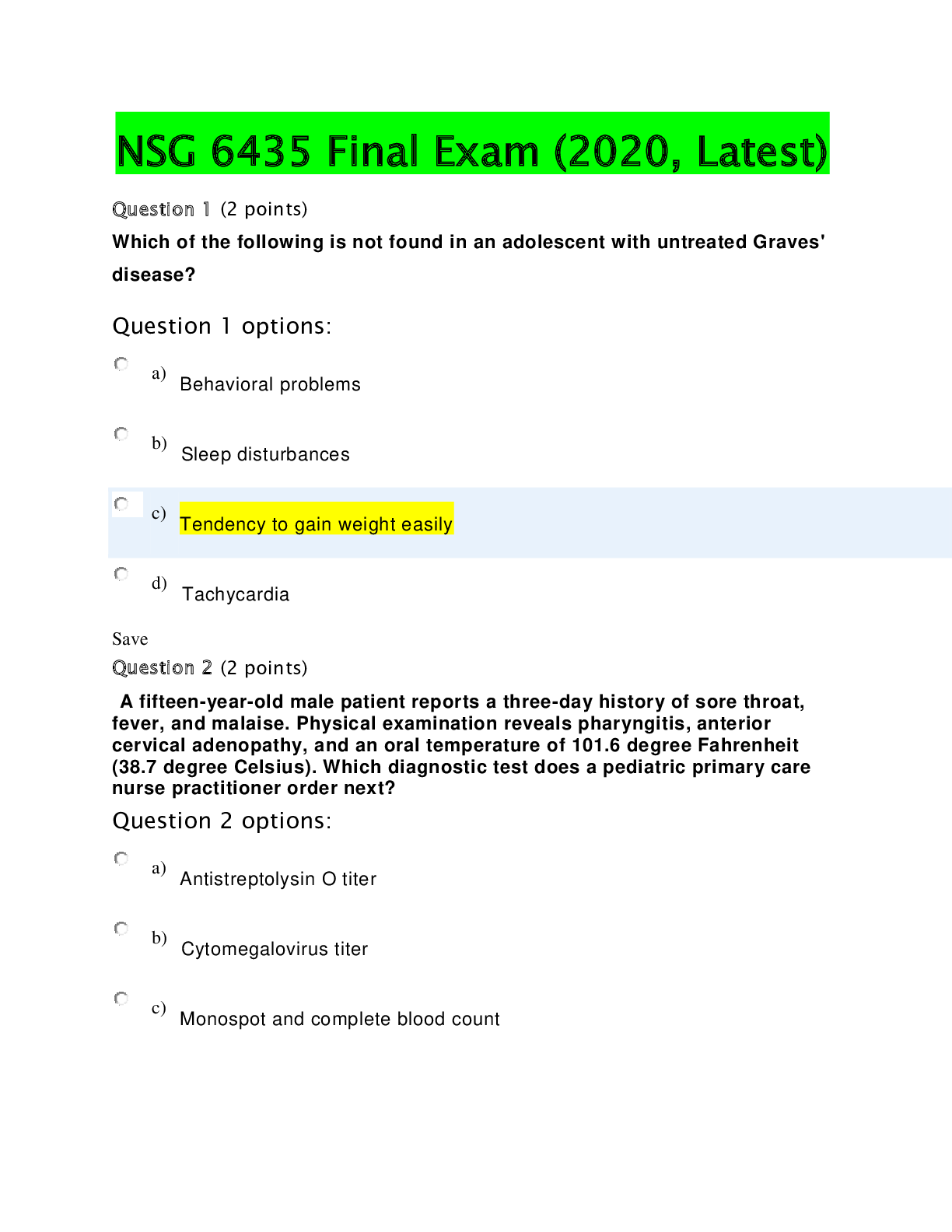
Reviews( 0 )
Document information
Connected school, study & course
About the document
Uploaded On
Apr 28, 2020
Number of pages
34
Written in
Additional information
This document has been written for:
Uploaded
Apr 28, 2020
Downloads
0
Views
78













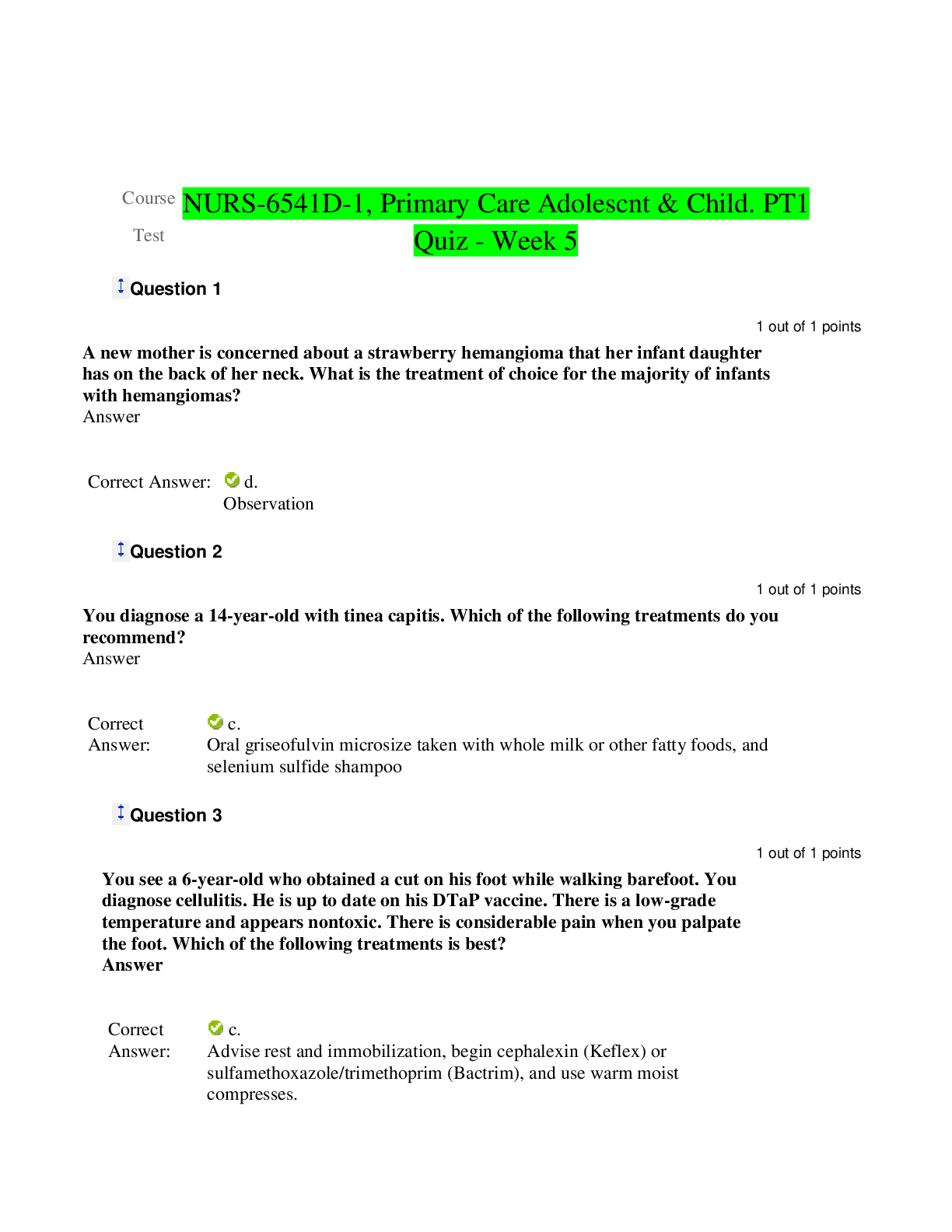


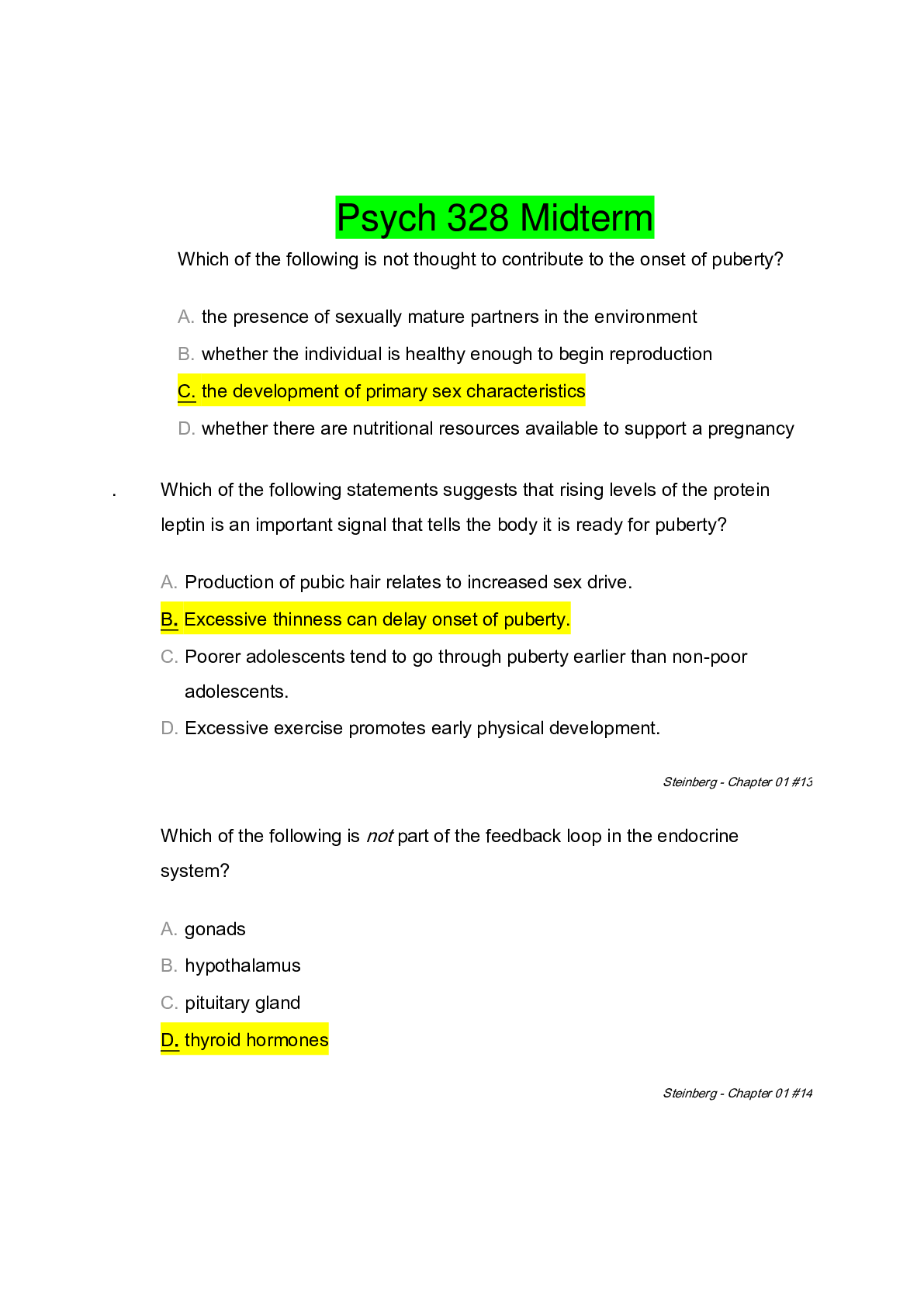
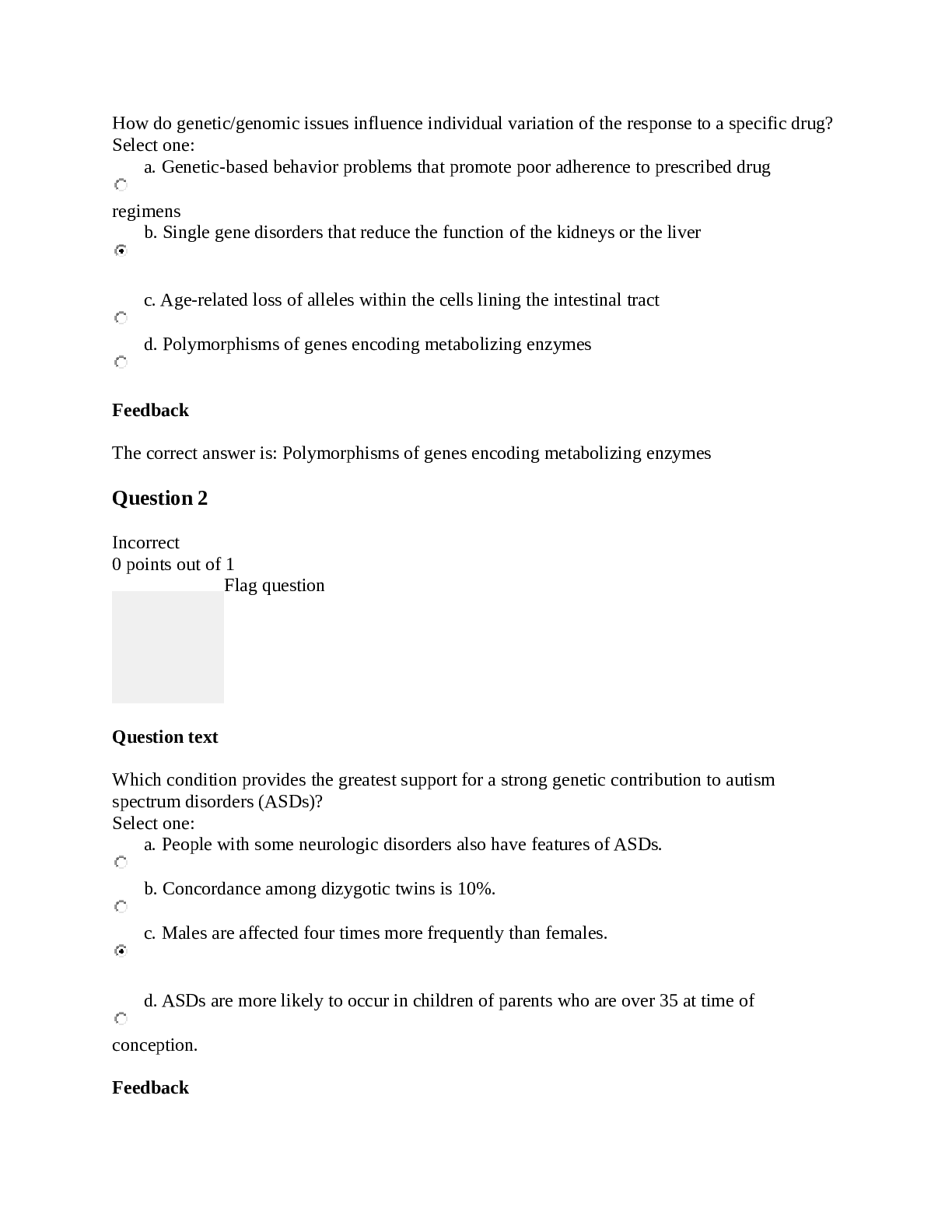
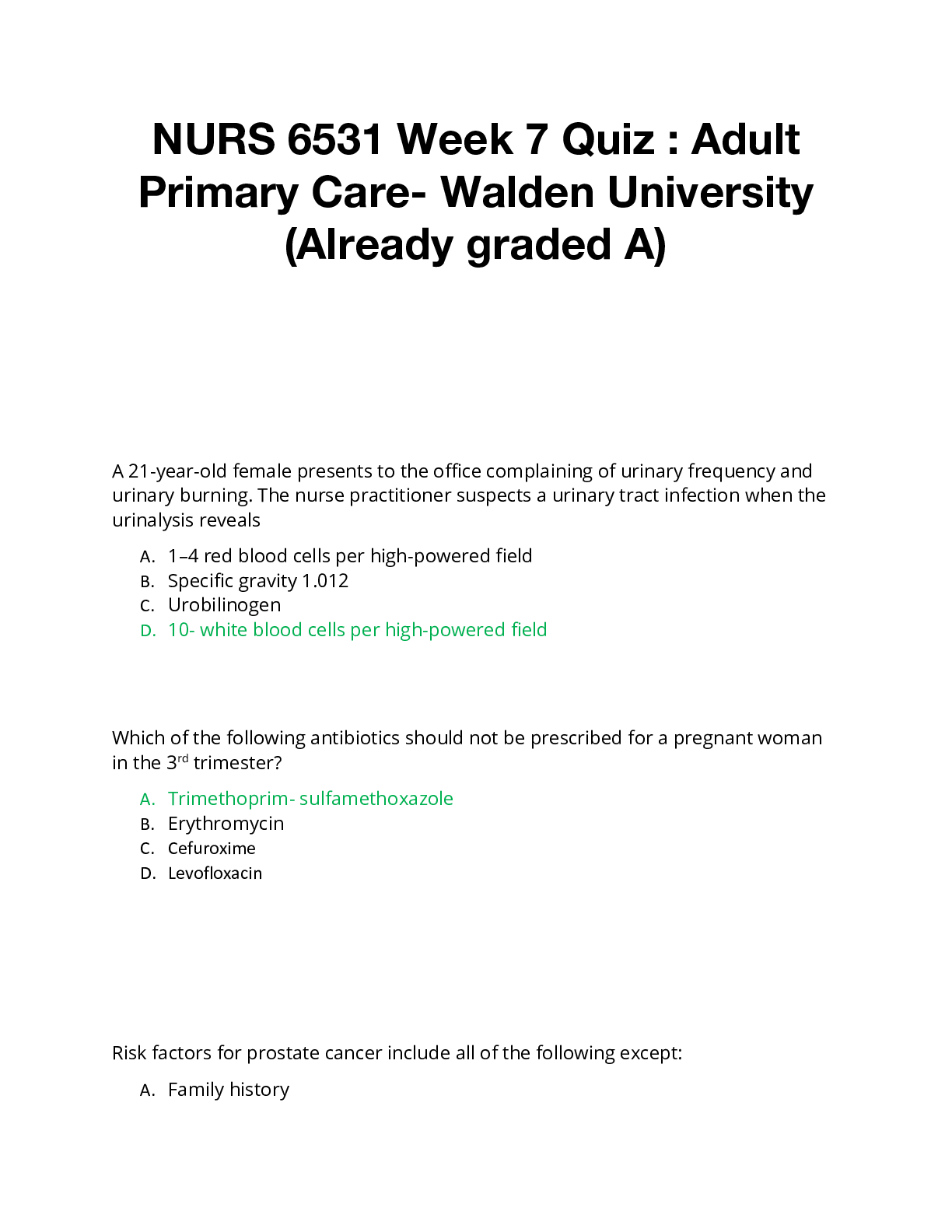

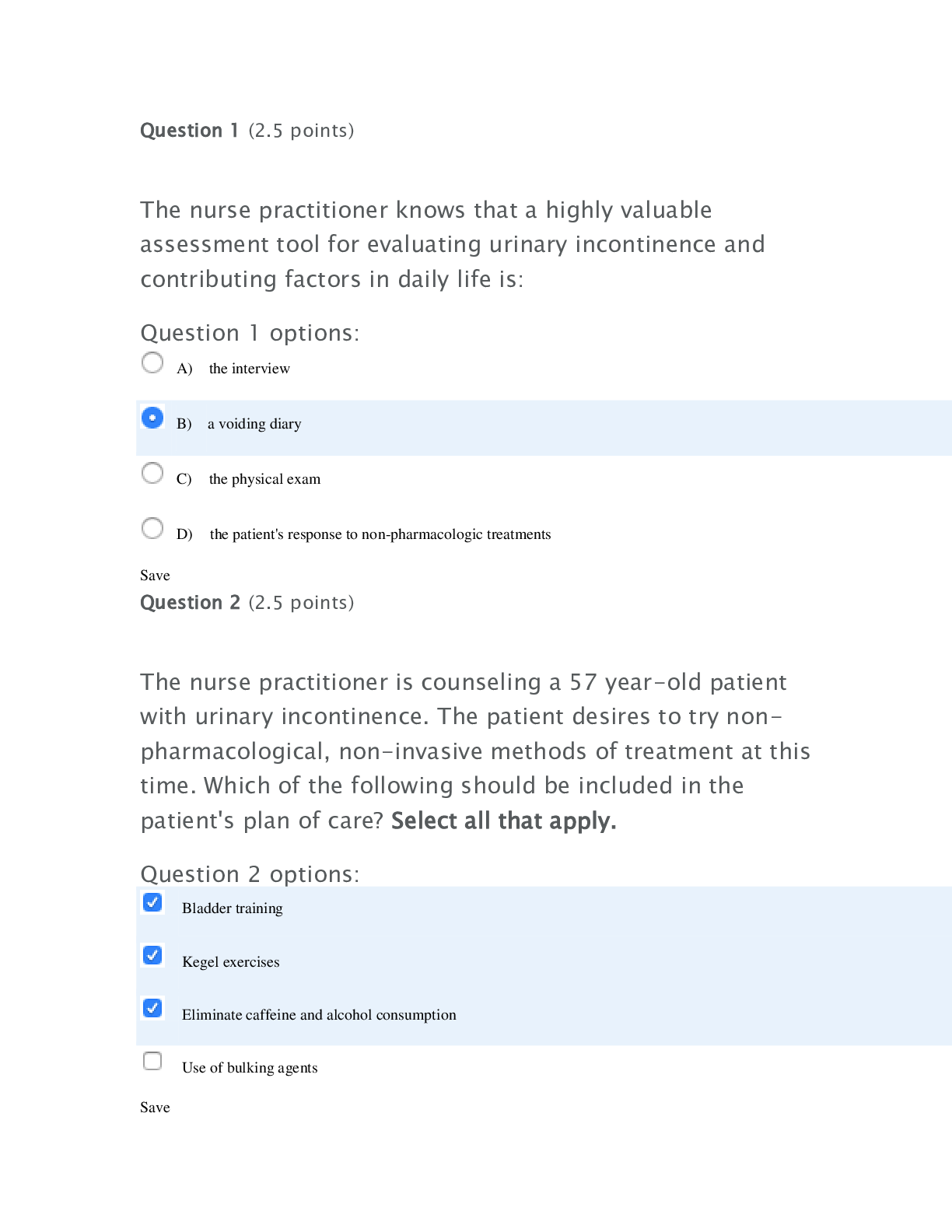
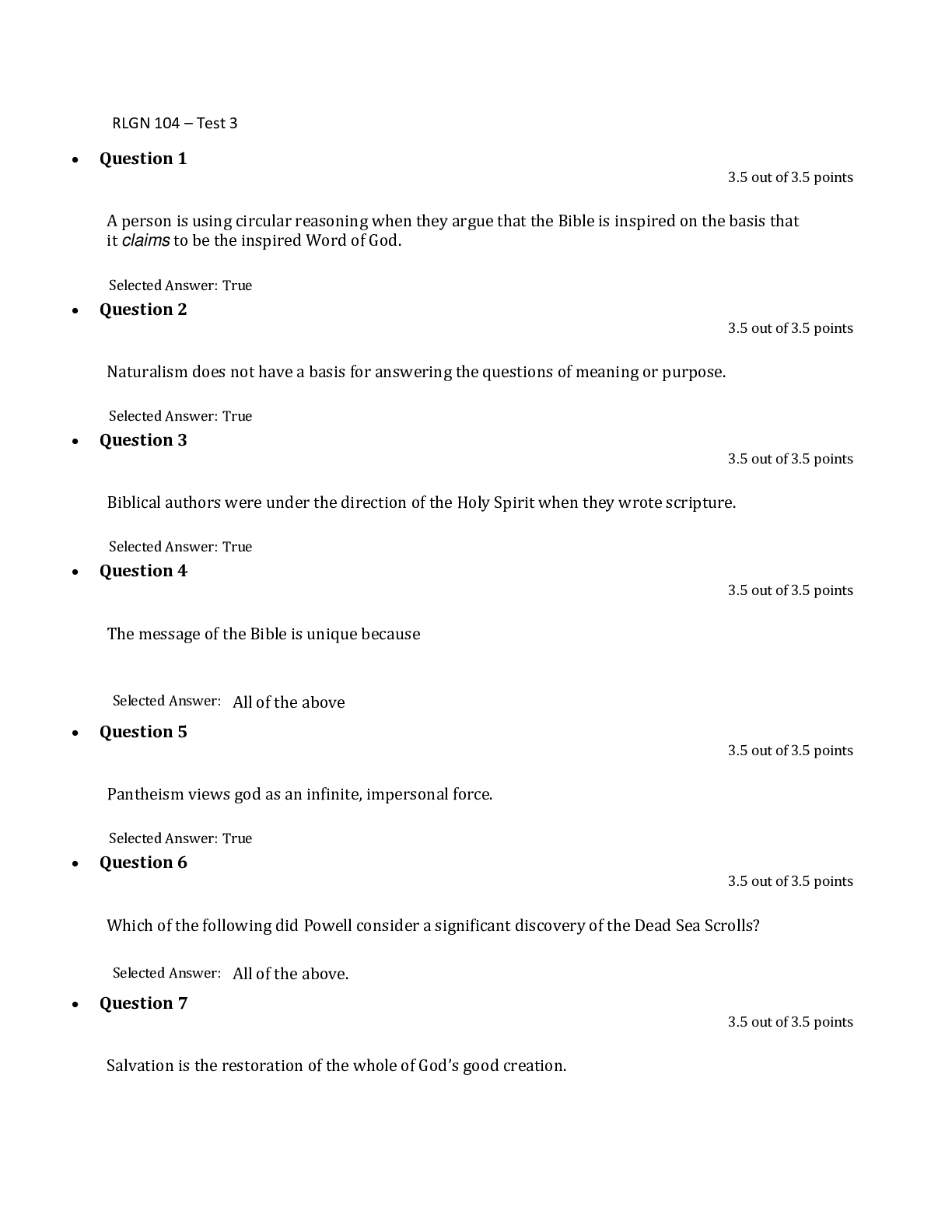
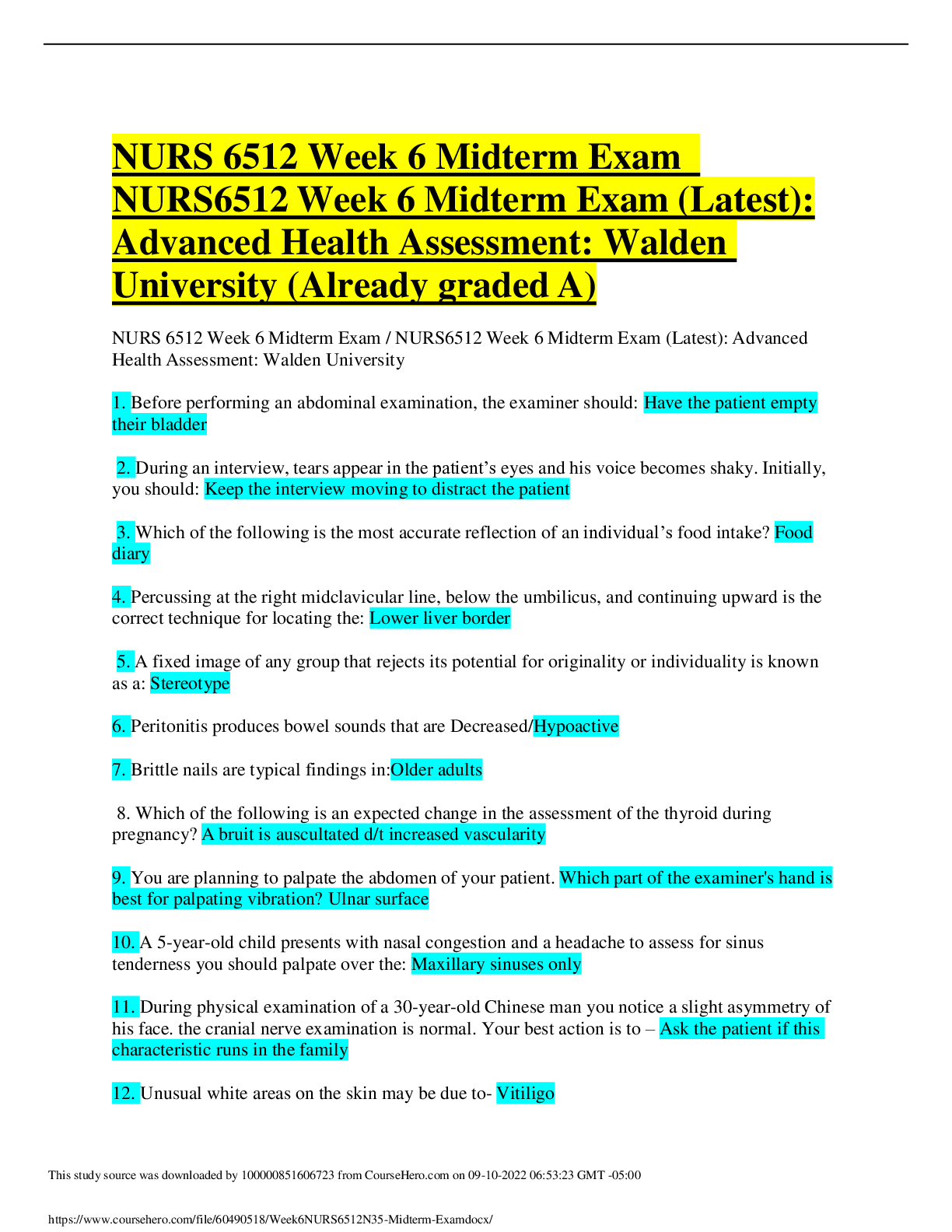
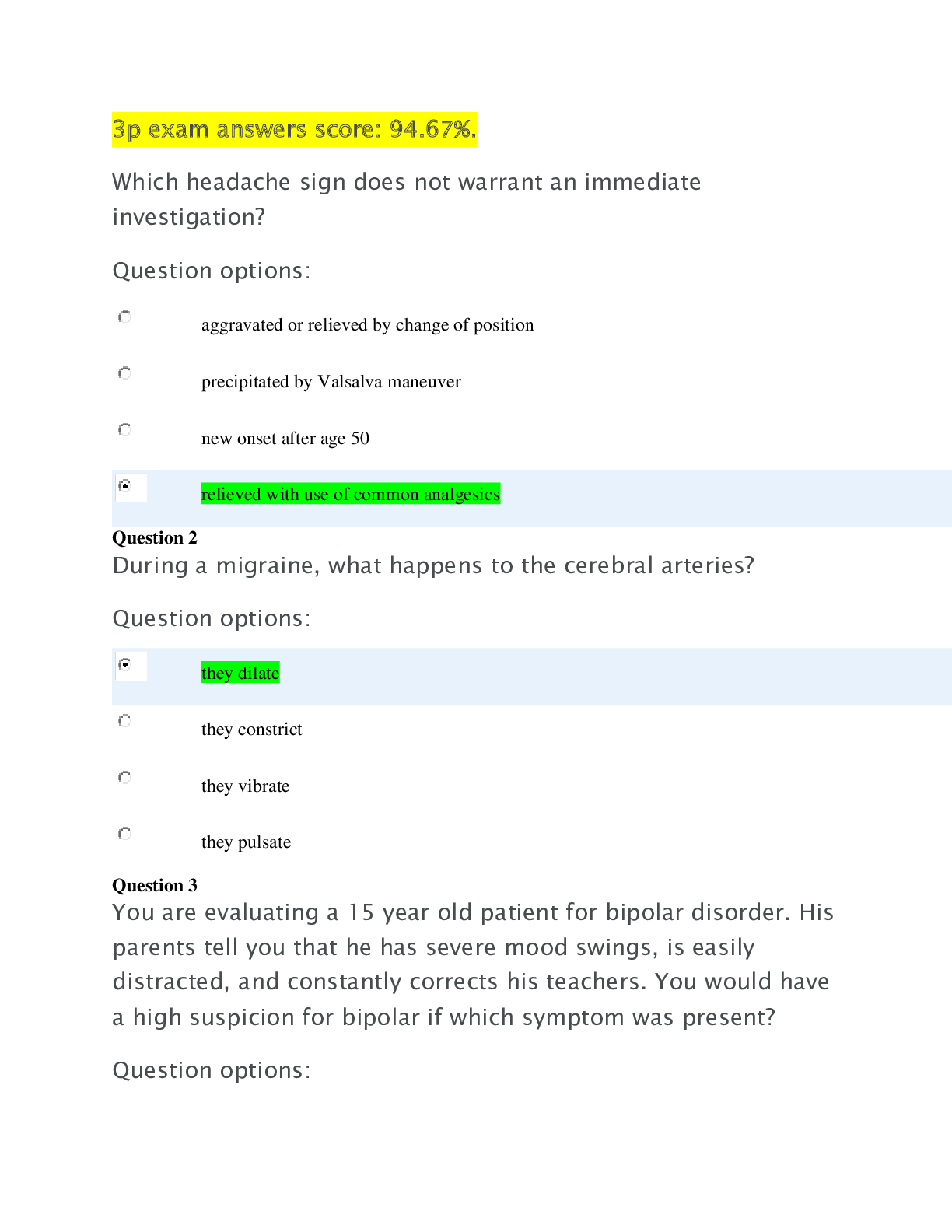

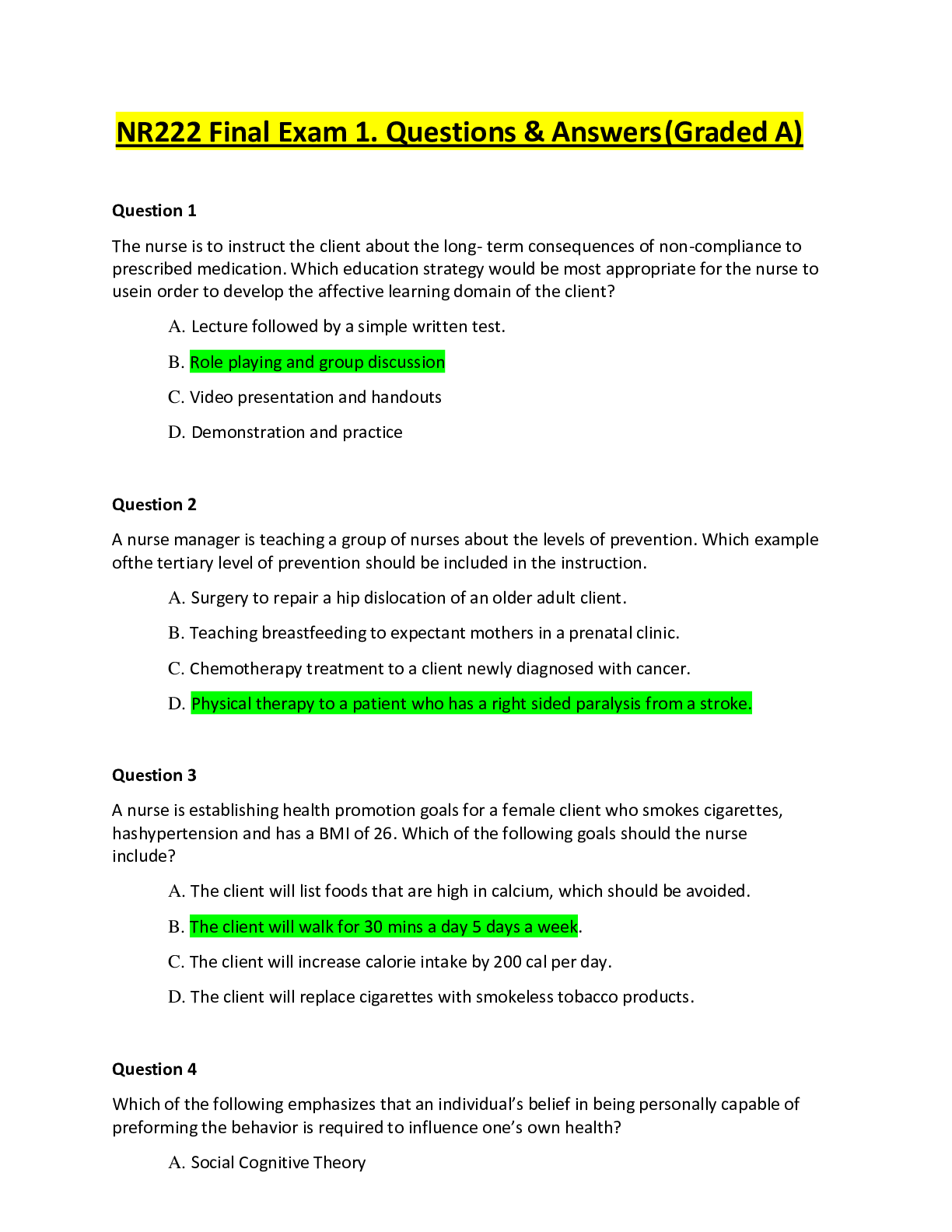


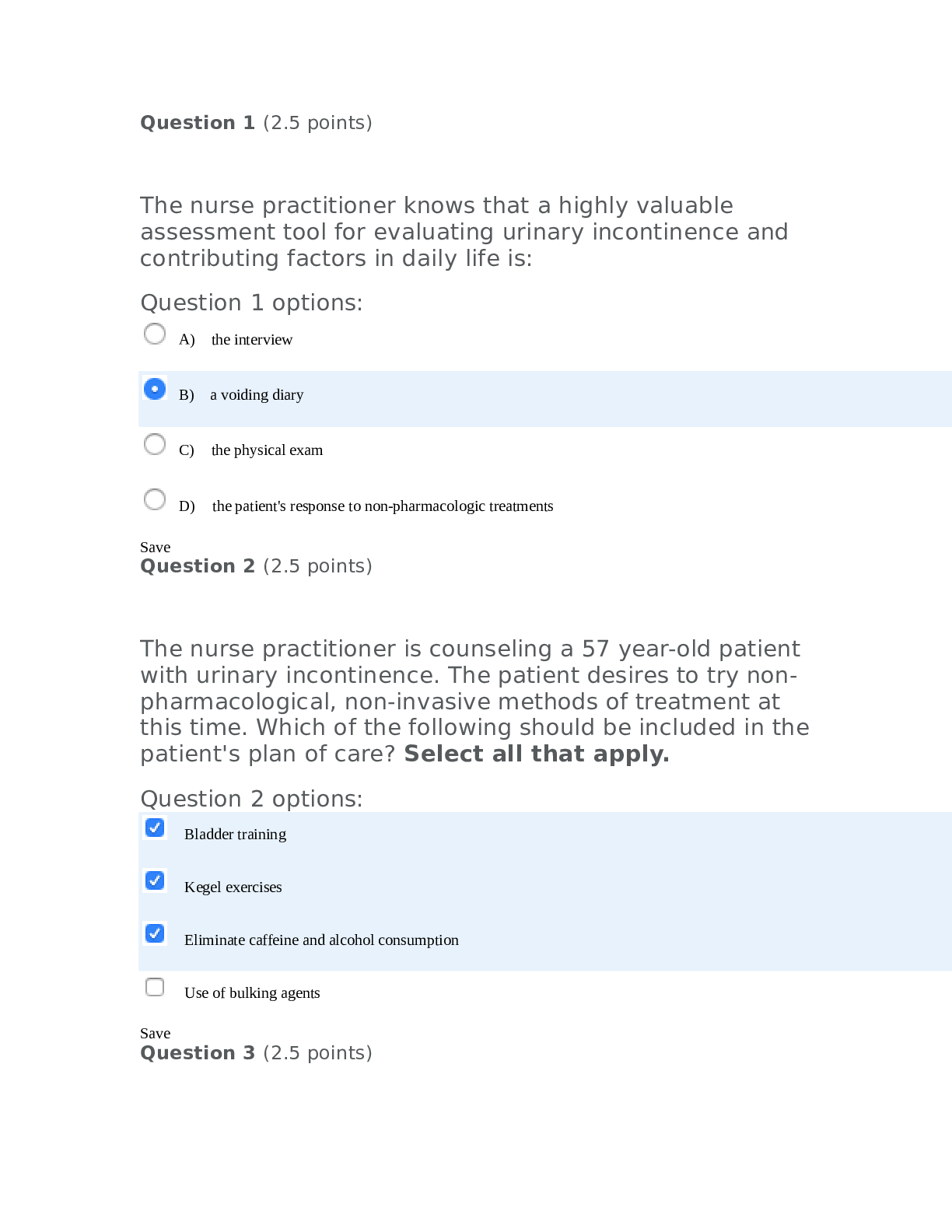
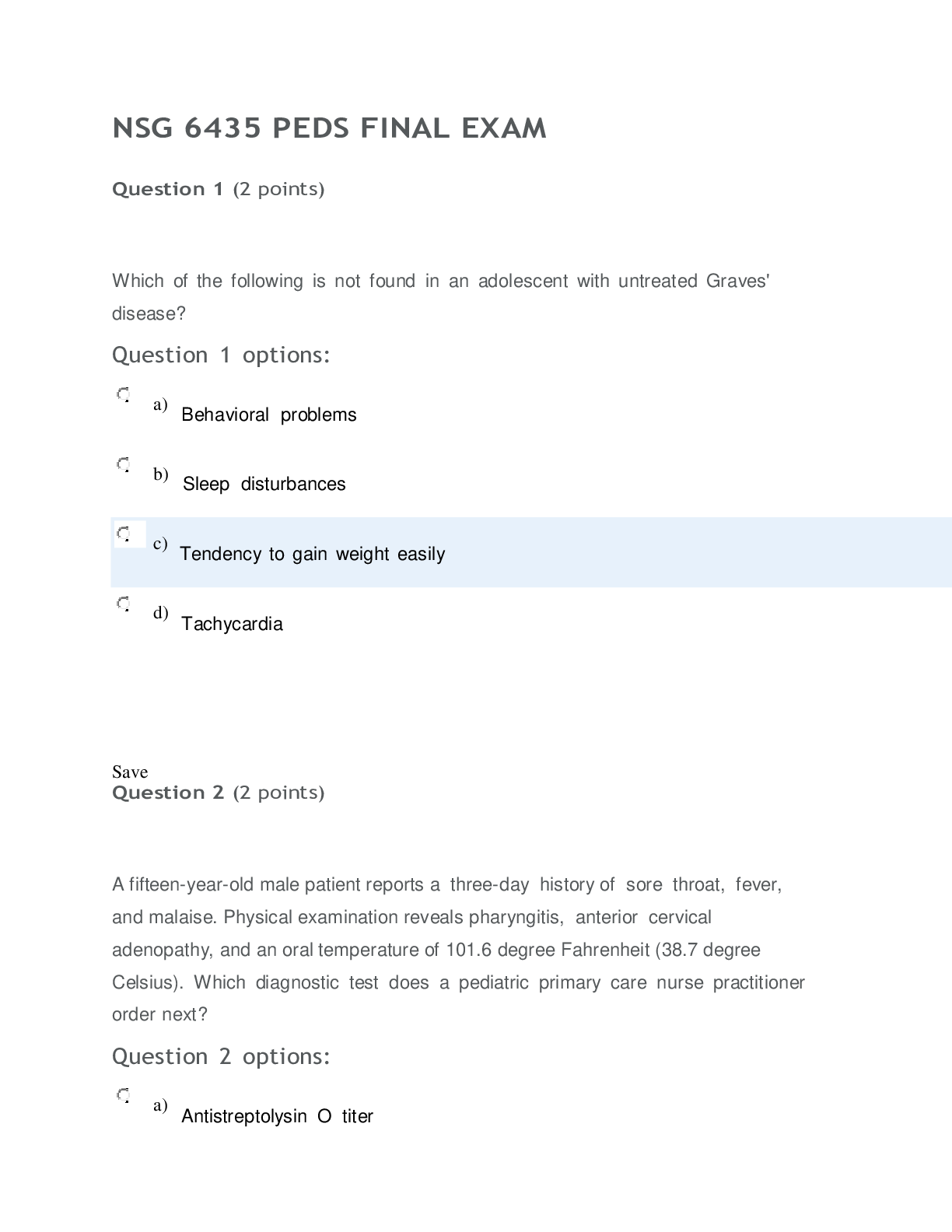

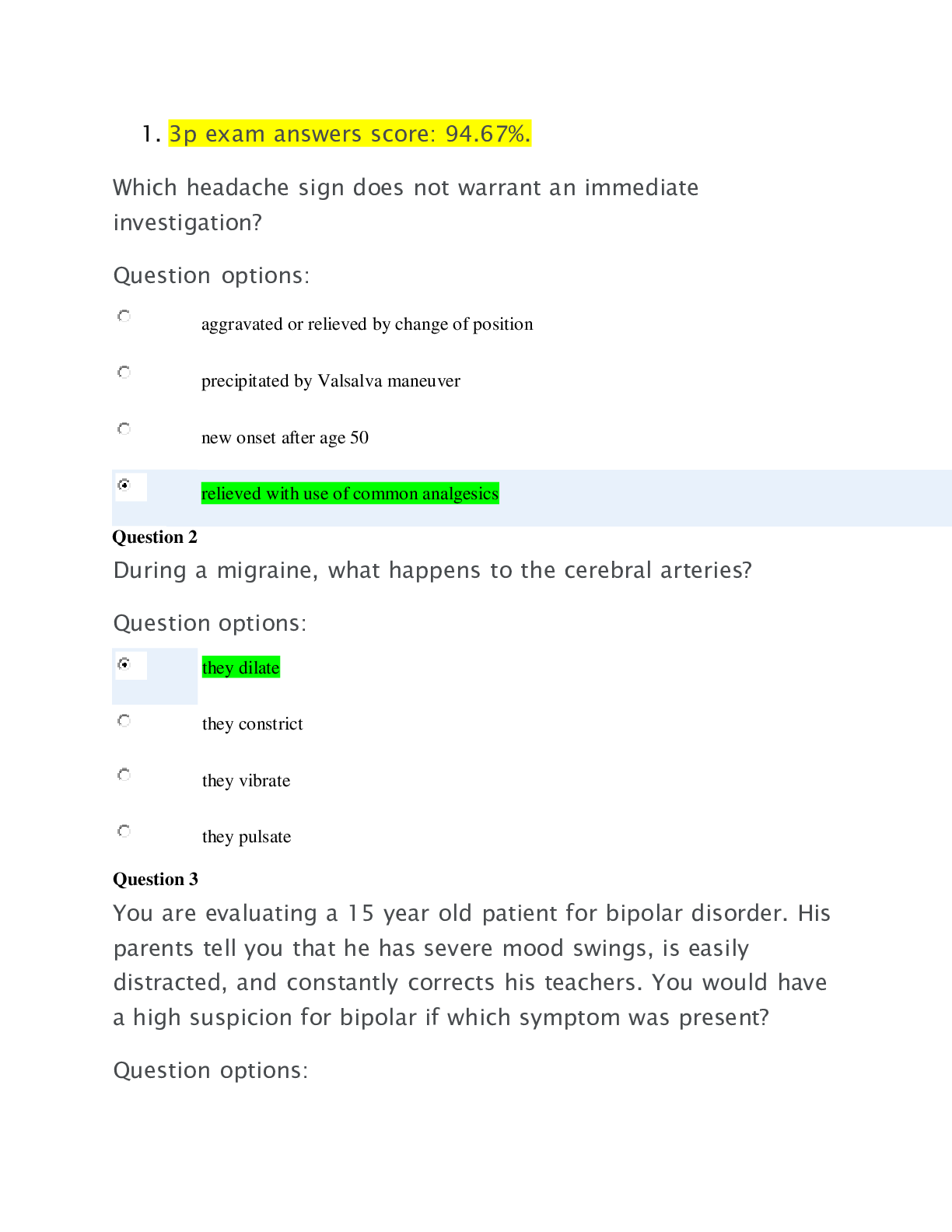
 NSG 6435 FINAL EXAM (LATEST-2020) CORRECT ANSWERS, GRADED A.png)
 NSG 6435 FINAL EXAM (LATEST-2020) CORRECT ANSWERS, GRADED A.png)

